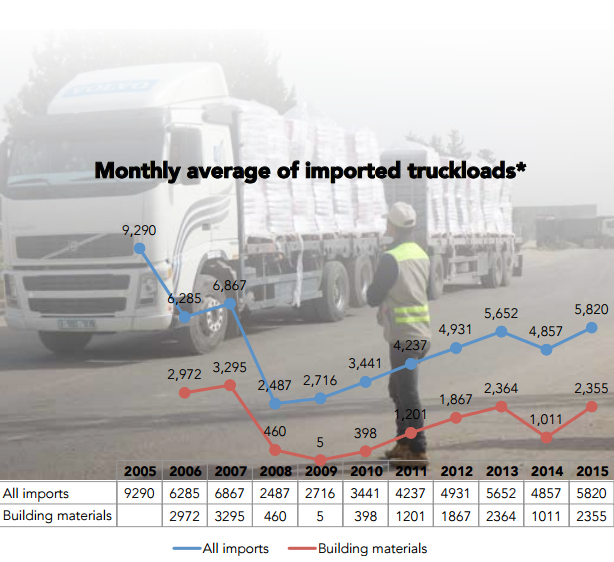Further easing of criteria and quotas for Israeli permits to exit Gaza
Commercial crossing to be upgraded to increase the volume of imports/exports
On 17 February, the Israeli Ministry of Defense announced a series of measures aimed at easing access restrictions in and out of Gaza, to improve the humanitarian conditions of the population.[1] These include a rise in the quota of exit permits for Palestinian merchants from 3,000 to 5,000 a month, an increase in the daily number of exits from 400 to 800 per day, and allowing textiles and furniture to be transferred to the West Bank for commercial purposes.[2] These measures are expected to facilitate employment generation within Gaza, although their precise impact depends on a range of additional factors.
This follows a similar package of measures announced in October 2014, following the summer hostilities,for the import of construction materials classified by Israel as “dual use items” as part of the temporary Gaza Reconstruction Mechanism (GRM), the resumption of commercial transfers of agricultural produce from Gaza to the West Bank, and the relaxation of criteria for the issuance of exit permits. The latter included a limited number of permits for people to visit family members held in Israeli prisons, non-urgent medical cases, and for people over 60 to visit East Jerusalem for Friday prayers.
While the easing measures are a welcome step, the majority of the Gaza population remains ineligible to apply for a travel permit and the volume of goods allowed out of Gaza for commercial purposes remains an insignificant fraction of the equivalent preblockade volumes (see below).
Upgrading of Kerem Shalom crossing
This month, both the Israeli and Palestinian authorities are carrying out infrastructure works at the Kerem Shalom commercial crossing to upgrade its capacity from 500to 800 truckloads of goods per day. These works include the upgrading of pipes used for the transfer of cooking gas and fuel on the Israeli side of the crossing, and the expansion of the loading area on the Palestinian side.[3] The works, which are scheduled to be completed in the next three to four months, are expected to shorten the waiting time for the entry and exit of goods and will facilitate commercial transactions.
Following Israeli’s unilateral closure of another three crossings with Gaza since 2007 (Karni, Nahal Oz and Sufa), and Egypt’s almost total closure of Rafah crossing (used for imports of limited quantities of construction materials) since mid-2013, Kerem Shalom has become the single operational gateway for the transfer of goods in and out of Gaza.
Irrespective of the ongoing upgrade, the volume of goods processed through the Kerem Shalom crossing in recent months has been on the rise. In February, 6,134 truckloads of goods into Gaza were processed, up by 26 per cent compared with the monthly average for 2014. This increase is largely due to the greater volume of construction materials, including those designated as dual use items, for the repair and reconstruction of homes and infrastructure damaged during the summer hostilities (see also Reconstruction section). However, February imports are still less than half of the monthly average during the first five months of 2007, just prior to the imposition of the blockade, entering via the four crossings.

In the last few months the volume of goods allowed out of Gaza has steadily risen as a result of the resumption of commercial transfers of agricultural produce from Gaza to the West Bank. During January and February, a total of 148 truckloads left Gaza, the majority to the West Bank. While this is three times higher than the figure for the first two months of 2014 (48 truckloads), it remains only a fraction of the nearly 2,500 truckloads that exited Gaza in January and February of 2007, prior to the blockade.
Latest Developments
On mid-March, Gaza-produced eggplants and tomatoes were allowed into Israeli markets for the first time since the imposition of the blockade in 2007. Further information and analysis on this development will be included in the March edition of the Humanitarian Bulletin.
[2] Initial reports of 50 one-time permits to be issued for Gaza students to study in West Bank were later denied by COGAT as a clerical error.
[3] The new area includes about 30 dunums to establish three new sections for unpacked cement, for outgoing agricultural produce, and for outgoing non-agricultural items such as textiles and furniture.









